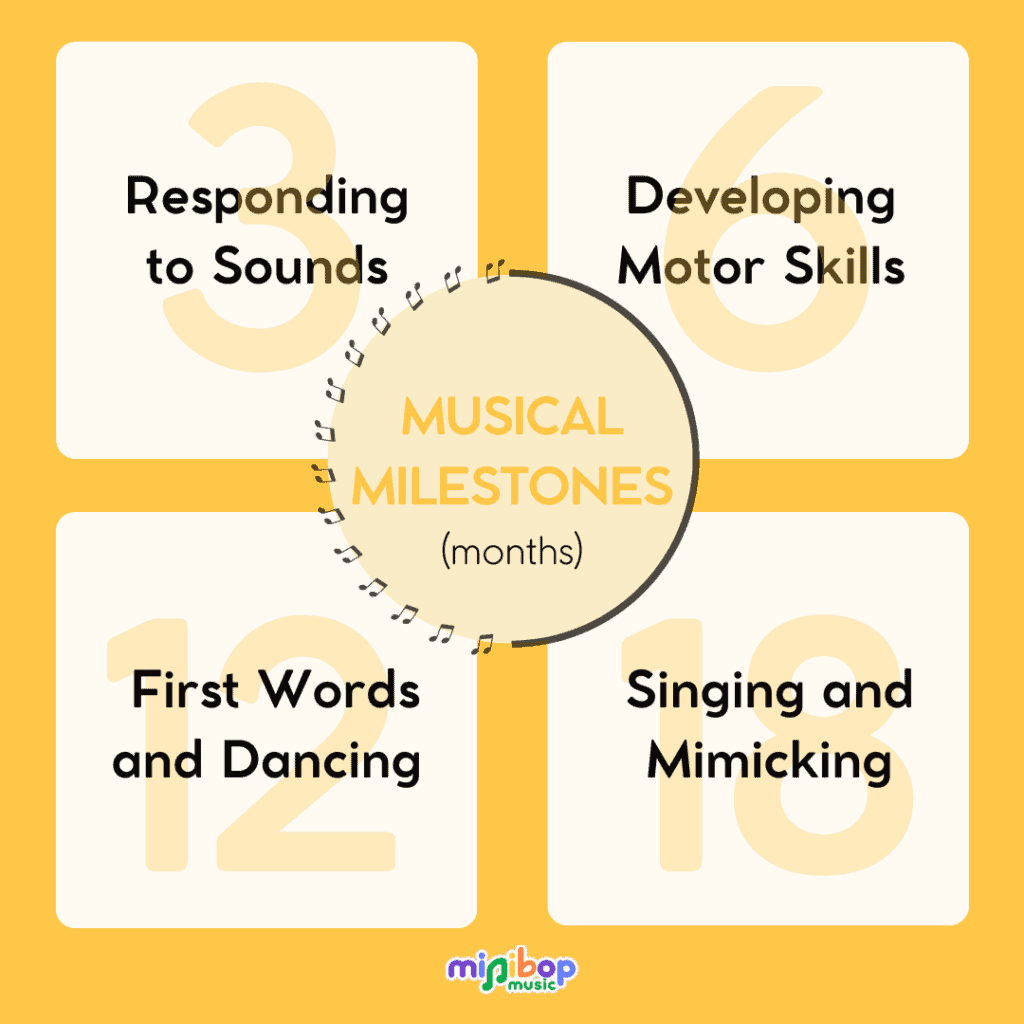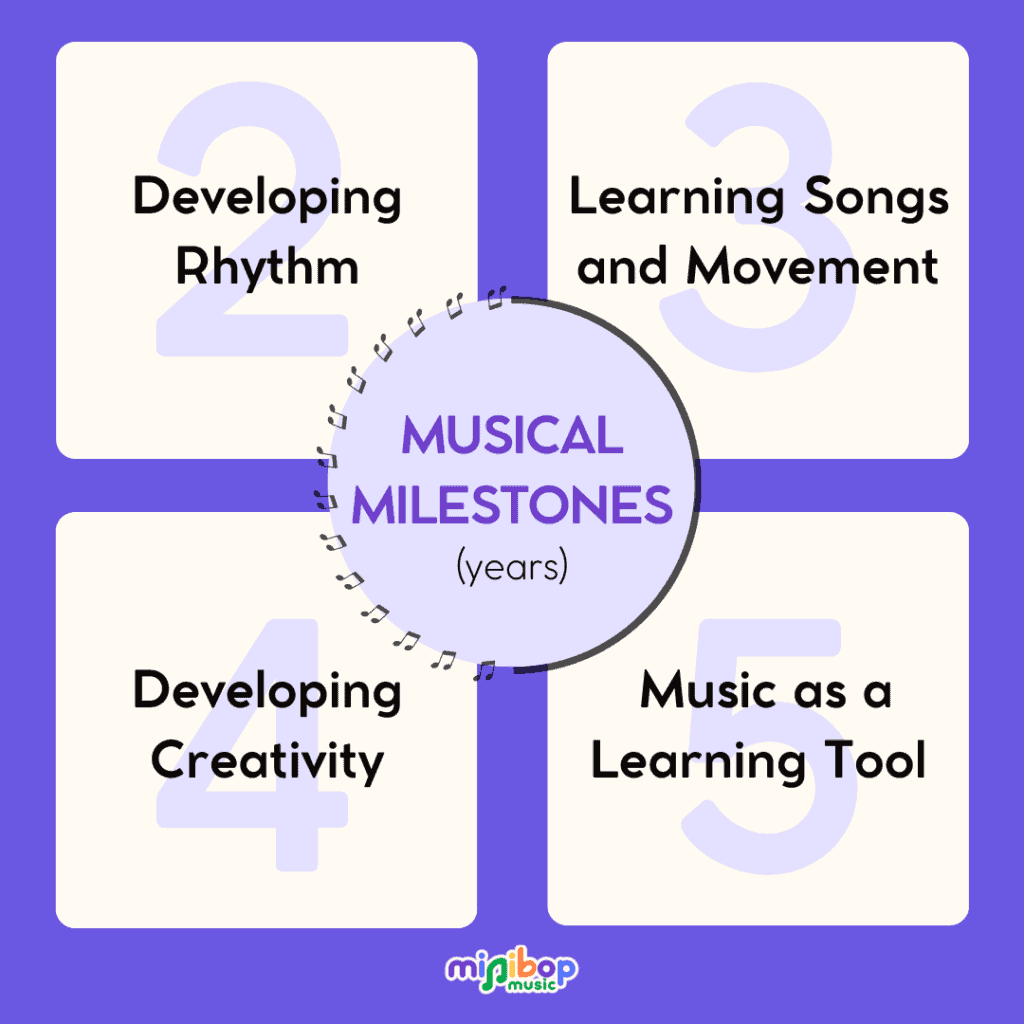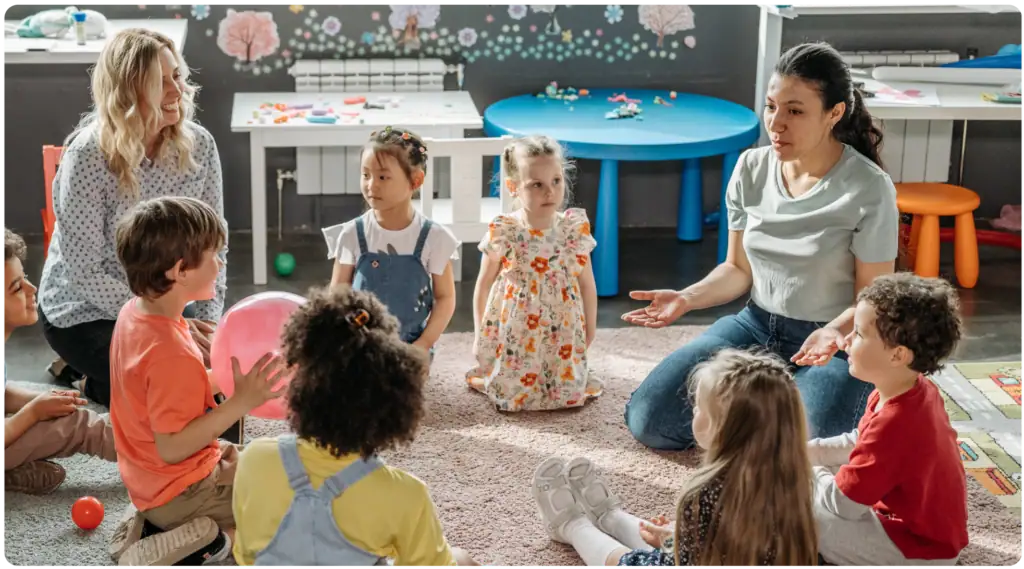From Babbling to Beethoven: A Parent’s Guide to Musical Milestones
As a parent, you want to give your child every opportunity to grow and develop. One way to do this is through music! So understanding the musical milestones of development is crucial.
Music has been shown to have a positive impact cognitive abilities, emotional regulation, and social skills.
But how do you know if your child is meeting their musical milestones?
In this comprehensive guide, we’ll cover everything you need to know about tracking your child’s musical milestones. We’ll start by breaking down the different age milestones, from 3 months to school age and beyond, and what to expect at each stage. Then, we’ll give you tips and tools to help you monitor your child’s progress and support their musical development.
Ready to get your little one developing motor and music skills with hands-on instrument play? Check out our expert curated list of the best children’s instruments on Amazon!
3 Months: Responding to Sounds
By three months, babies are becoming more aware of the world around them. They may begin turning their head toward sounds or showing preference for certain voices. Music can encourage this growing awareness.
- What to look for: Does your baby quiet down and listen when music plays? Do they move their arms or legs in response to a strong beat?
- How to nurture: Play music with a clear rhythm (e.g., classical or rhythmic lullabies). Observe if your baby shows signs of engagement, such as increased alertness or movement.
Research Note: Infants as young as two to three months old show sensitivity to pitch changes and melodic contours (Trehub, 2003). This early sensitivity suggests that babies are primed to respond to musical input.
6 Months: Developing Motor Skills
Around six months, babies start to refine their motor skills. They may sit up with support and begin reaching for objects. Music can enhance these emerging abilities.
- What to look for: Can your baby hold objects like rattles and move them in time with a beat? Do they reach for objects when they hear music?
- How to nurture: Play lively, fast-tempo music and encourage your baby to clap (with assistance) or move their arms to the beat. This helps reinforce hand-eye coordination and rhythm perception.
Research Note: A study published in Developmental Science found that exposure to rhythmic and melodic patterns can strengthen infants’ abilities to detect and predict auditory sequences (Hannon & Trainor, 2007).
12 Months: Babbling and Dancing
By twelve months, children often begin babbling or even speaking their first words and may be taking their first steps. This is also a time when dancing or swaying to music emerges.
- What to look for: Does your child bounce or sway when music plays? Are they babbling or trying to imitate words in songs?
- How to nurture: Sing simple songs and encourage your child to repeat key words. Play music with a strong beat to inspire dancing or basic movement.
Why it matters: Early musical play fosters the coordination between movement and sound, a foundational skill for later, more complex musical abilities (Zentner & Eerola, 2010).

18 Months: Singing and Mimicking
At eighteen months, toddlers often start to mimic the words and melodies they hear in their environment.
- What to look for: Is your child trying to sing parts of a song? Do they mimic rhythms by clapping or tapping on surfaces?
- How to nurture: Choose songs with simple, repetitive lyrics. Encourage them to follow along with clapping or gentle dancing. Positive feedback—like smiling, nodding, or clapping—reinforces confidence.
Pro Tip: Record short videos of your toddler singing or imitating sounds. Looking back on these can help you see progress over time.
2 Years: Developing Rhythm
By age two, many children show an emerging sense of rhythm—clapping hands in time to music or even jumping to a beat.
- What to look for: Does your child keep a basic beat? Do they try to maintain a steady tempo when clapping or tapping?
- How to nurture: Introduce music with different tempos. Have them stomp, clap, or shake a small instrument in time. Gradually vary the speed to refine their timing and motor skills.
Science Says: Research indicates that rhythm perception is closely linked to language development because both rely on auditory pattern recognition and timing (Gordon et al., 2015).
3 Years: Learning Songs and Movement
Around three years old, children begin to learn more complex songs and choreographed movements.
- What to look for: Can your child sing along to full nursery rhymes? Do they enjoy copying dance moves they see on TV or in music videos?
- How to nurture: Experiment with songs that have distinct sections (verse, chorus) and multiple tempos. Encourage them to create simple dances or follow along with family members.
Why it matters: Learning entire songs helps children develop memory, vocabulary, and comprehension skills (Bolduc, 2009).
4 Years: Developing Creativity
By age four, children start showing more creative flair. They may invent their own songs or movements.
- What to look for: Is your child spontaneously making up tunes or changing the lyrics of a familiar song?
- How to nurture: Provide child-friendly instruments—like small keyboards, percussion instruments, or a ukulele—and let them experiment. Encourage songwriting by asking them to “tell a story” with their music.
Tip: Give children space to explore music in an unstructured way. This helps nurture both their imagination and their confidence as musically inclined creators.

Entering School: Music as a Learning Tool
As your child enters school (such as Transitional Kindergarten in California), consider leveraging music to support academic skills. Multiple studies have linked music education to improved memory, language processing, and reading comprehension (Schellenberg, 2004; Moreno et al., 2009).
What to look for: Does your child enjoy more structured musical experiences, like group lessons or school choirs?
How to nurture: Enroll them in beginner music lessons or encourage participation in a school band or choir. This structured learning can enhance discipline and teamwork while refining musical skills.
Experts Tips for Tracking Musical Milestones
Now that you know what to expect at each stage of your child’s musical development, how can you track their progress? Here are some tips and tools to help you monitor your child’s musical milestones:
Keep a Musical Diary or Photo/Video Album
Document your child’s musical activities—from first claps to full-fledged performances. Regularly reviewing these moments makes it easier to see progress and identify areas to support.
Use a Musical Milestone Checklist
Checklists (available online or through early childhood educators) offer common benchmarks for different ages. Remember that each child develops at their own pace, so use these merely as guidelines.
Attend Music Classes
Group music classes designed for young children introduce variety in songs, instruments, and styles. They also help children learn social and collaborative skills. Look for programs that incorporate singing, movement, and hands-on instrument play.
Provide Musical Instruments
Start with simple items—like shakers, drums, or xylophones. As your child’s coordination and interest grow, introduce more complex instruments (keyboard, violin, or guitar).
Sing and Play Music Together
Whether it’s a lullaby at bedtime or a dance party in the living room, shared musical experiences strengthen your bond and nurture your child’s growing sense of rhythm, language, and creativity.
Different types of music to stimulate musical milestones and development.
When it comes to music and child development, not all types of music are created equal.
Some types of music can be more beneficial for certain aspects of child development than others.
Here are some of the types of music that have been found to be particularly effective in stimulating child development:
Classical Music
- Linked with enhanced focus, spatial-temporal reasoning, and potential improvements in cognitive functions (Rauscher, Shaw, & Ky, 1993).
- Great for quiet time, fostering concentration and mindfulness.
Folk Music
- Introduces diverse musical styles and rhythms from various cultures.
- Often features simple, repetitive patterns that young children can easily imitate.
World Music
- Explores complex rhythms and instruments from around the globe.
- Broadens musical horizons and cultivates cultural awareness and respect.
Pop Music
- Encourages kids to connect with peers who share similar musical tastes.
- Catchy melodies and upbeat rhythms can spark a child’s natural energy and engagement.
Children’s Music
- Tailored for young ears with simple melodies, repetitive rhythms, and age-appropriate lyrics.
- Helps develop language, literacy, and foundational musical concepts in a fun, accessible format.

Final Thoughts on Musical Milestones
Tracking your child’s musical milestones can be an exciting journey—one that may reveal they are musically inclined or possibly even musically gifted.
By recognizing what to expect at each stage, you can confidently support their development through purposeful activities, classes, and daily musical play.
Remember to keep the experience joyful and exploratory, whether they’re singing along to their favorite tune or experimenting with a brand new instrument. Embracing music as a lifelong companion can enrich your child’s cognitive, social, and emotional well-being for years to come.
References
- Bolduc, J. (2009). Effects of a music program on kindergartners’ phonological awareness skills. Psychology of Music, 37(2), 195–207.
- Gordon, R. L., Shivers, C. M., Wieland, E. A., Kotz, S. A., Yoder, P. J., & McAuley, J. D. (2015). Musical rhythm discrimination explains individual differences in grammar skills in children. Developmental Science, 18(4), 635–644.
- Hannon, E. E., & Trainor, L. J. (2007). Music acquisition: Effects of enculturation and formal training on development. Trends in Cognitive Sciences, 11(11), 466–472.
- Hyde, K. L., Lerch, J., Norton, A., Forgeard, M., Winner, E., Evans, A. C., & Schlaug, G. (2009). Musical training shapes structural brain development. Journal of Neuroscience, 29(10), 3019–3025.
- Moreno, S., Marques, C., Santos, A., Santos, M., Castro, S. L., & Besson, M. (2009). Musical training influences linguistic abilities in 8-year-old children: More evidence for brain plasticity. Cerebral Cortex, 19(3), 712–723.
- Rauscher, F. H., Shaw, G. L., & Ky, C. N. (1993). Music and spatial task performance. Nature, 365(6447), 611.
- Schellenberg, E. G. (2004). Music lessons enhance IQ. Psychological Science, 15(8), 511–514.
- Standley, J. M. (2008). Does music instruction help children learn to read? Evidence of a meta-analysis. Update: Applications of Research in Music Education, 27(1), 17–32.
- Trehub, S. E. (2003). Musical predispositions in infancy. Annals of the New York Academy of Sciences, 999(1), 1–16.
- Zentner, M., & Eerola, T. (2010). Rhythmic engagement with music in infancy. Proceedings of the National Academy of Sciences, 107(13), 5768–5773.
For more hands-on strategies, downloadable checklists, and age-by-age activities, don’t forget to explore The Baby & Toddler Music & Development Guide – for parents. Your child’s first steps into the world of music may be small, but they can pave the way for a lifetime of creativity, expression, and joy.






